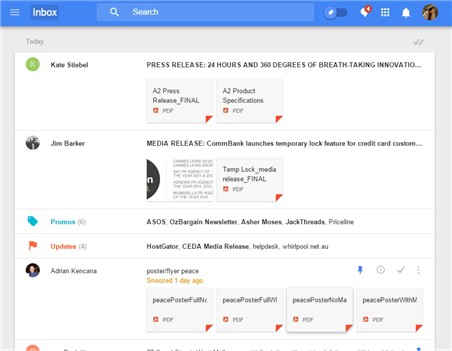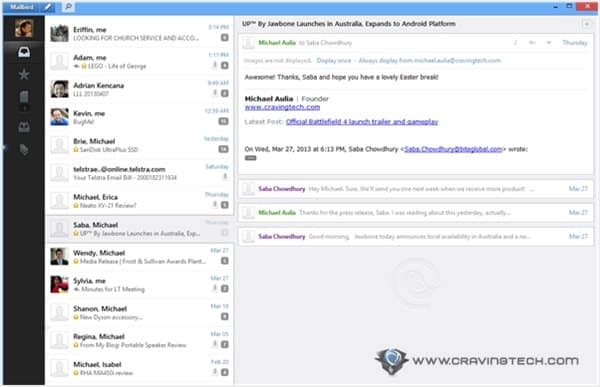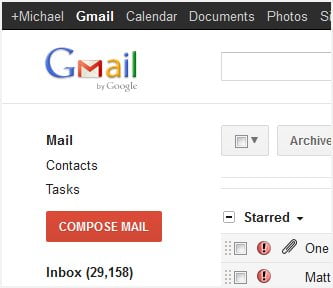
Note: This is a guest post written by Andrea Loubier, CEO of Mailbird. For more info about Mailbird, make sure to check out Craving Tech’s impression on Mailbird.
The Problem with Email
Email was literally the greatest technological advancement made to human communication in the 20th century, and…it still is. However what we see these days are a lot of people complaining about email that it’s too slow, it’s not secure enough, it’s ugly, it doesn’t work for how my team communicates in the work place, it kills my productivity, it’s very distracting, I have too much email, I wish I could check all my email from different accounts in one place, it’s boring and the list goes on.
I am almost certain that you have one of the aforementioned email complaints, and if not, your own unique complaints. For something that is a prominent technology used worldwide, this is something that deserves a closer look.
A deep investigation into the pursuit of email happiness. Gina Trapani, blogger for Lifehacker, says it well,
“While I agree that an overstuffed inbox and constant email monitoring can kill your day, this $700 billion a year cost to the American economy makes me raise one eyebrow high in doubt. Did researchers factor in how much time email actually saves people who use it? I get dozens of messages per day and spend a good amount of time managing all of them. I’m the first to complain about what a time sink email can be. However, if I had to get on the phone or mail a letter to Adam, Kevin, Tamar, and Jason every time I wanted to tell them something? Nothing would get done around here” – Read article
Data on people + email + productivity and email usage
So how can we change this perception and practical use of email from a Productivity-Hole to a Productivity-Hub as it was intended to be? Let’s start with some stats.
- The average information worker–basically anyone at a desk–loses 2.1 hours of productivity every day to interruptions and distractions, according to Basex, an IT research and consulting firm. That time is money – Read article
- Computer chip giant Intel, for one, has estimated that e-mail overload can cost large companies as much as $1 billion a year in lost employee productivity – Read article
- E-mail volume is growing at a rate of 66% a year, according to the E-Policy Institute – Read article
- Research conducted by the University of California and the U.S. Army reveals that cutting employees from email reduces their stress and enables them to resist work interruptions. The implications of this suggest that organizations should consider sending out emails in batches to counter the belief that email should be answered as soon as possible and curb employees’ desire to self-interrupt. “There are social expectations intertwined with email,” says Mark. “We expect that when we send an email, people will respond as quickly as possible. We also drive ourselves to answer the email as quickly as possible, perhaps just to get it out of our inbox.” – Read article
- Search and email remain the top online activities. Among online adults, 92% use email, with 61% using it on an average day – Read article
- The number of worldwide email accounts continues to grow from over 4.1 billion accounts in 2014 to over 5.2 billion accounts by the end of 2018 – Read article
- The total number of worldwide email users, including both business and consumer users, is also increasing from over 2.5 billion in 2014 to over 2.8 billion in 2018 – Read article
- Email remains the most pervasive form of communication in the business world, while other technologies such as social networking, instant messaging (IM), mobile IM, and others are also taking hold, email remains the most ubiquitous form of business communication – Read article
- Business users send and receive on average 121 emails a day in 2014, and this is expected to grow to 140 emails a day by 2018 – Read article
- Sometimes it feels like half of them are in your inbox: MarketingProfs says that 122,500,453,020 emails are sent every hour – Read article
It’s clear that email continues to prevail as the #1 form of communication for eons to come. So where does the root of the problem lie? Bill Gates of Microsoft says,
“We need better products to manage the information we do get. The problem is that the information exists, but it is not in one place and cannot be easily viewed in a meaningful way using today’s software. You have to seek the information out…it is spread across different systems,” Gates said in 2005 – Read article
Software solutions can definitely deliver efficient means of information management via email, hence why at Mailbird, we are working our asses off to fulfill the big vision of building the world’s best email solution that is highly secure, fast and innovative.
What it means to be productive when email is a major part of your job: Get more with less work philosophy
To understand what it means to be productive when email is a major part of your job, we should start with what people do wrong with email that leads to their deep dismay of it, despite the necessity for it in their daily life. Here are common misuses of emails that lead us to asking, “Why are people so bad at email?”
- Email is not always the best medium for communication. Yes, this may be surprising coming from an email company, but the point is to educate people on how to use email effectively. Sometimes we waste more time with writing emails that don’t close the communication loop, because they are poorly structured and require a lot of back and forth discussion.For longer discussions that require a lot of ping ponging between people, communication in real-time and in-person is better suited and faster, especially if the subject is time sensitive. Save the time you spend emailing back and forth, so you can focus on the really important stuff that matters for your work.
- Not being direct and assuming the recipient understands your tone. It’s probably one of the #1 complaints about email, and just about everyone who uses email has some kind of story to share on this topic which usually points the blame at email and not the person. Important that as email users, our communication is kept succinct, direct and polite.If you feel that there could be any chance of misinterpretation, edit your email so it comes off more professional and leave the emotions out of it. We recommend that you don’t express emotions through an email – and yes that goes for those of you who are guilty of using ALL CAPS and lots of “!!!!’s” However, the occasional smiley face doesn’t hurt as long as you know it will not affect the professionalism of your email based on whom you are communicating with.
- Leave the other person hanging. Ever send an email with several important points or questions that require a direct response from the recipient, but to only then be ignored or receive a short and generalized response. “It is as if they didn’t even read the email!” you might say. Then the same people complaining about an inadequate email response are then also guilty of either not replying to an email at all or not addressing all the key points requiring specific responses.
- Un-managed Inbox. We aren’t suggesting that you attend to every email immediately as it arrives in your inbox because that is the problem most modern online workers face. On the other hand, we also aren’t saying to completely ignore your email leaving your inbox as a complete tornado of un-filtered information, where prioritization is a lost cause. That’s why we recommend dedicated times to email processing. That’s right, schedule your time in your inbox and get some work done, vacant of constant email notifications and interruptions. Literally, close down your email when you set time to focus on work.When you do sit down to tackle your inbox, using filters and folders help you organize and prioritize the information flowing through. Why? Because it saves you time in the long run leading to a healthier and more effective use of email. Search is also a key factor here, as it is important to be able to find things easily in your inbox. Reduce the stress of a hectic inbox and learn to set appropriate and limited times for email while implementing organization techniques that ease the tension every time you open up your inbox.
- Let email take over your work day. It is often that many of us walk into the office and what is the first thing we do? You got it, check email. Many of us even start it before we get to the office during our morning commute via our mobile phones. Then you get stuck. Once you start you cannot stop. Before you know it you are pulled in several different directions and you don’t get to start on the task you had originally planned to get done that day. Some of us are good at muting the noise in our inbox and setting priorities, but for those of us who struggle with prioritization we recommend starting your day with the most important task, then once you get that done set a limited time to check email.First scan (not read) emails to pick out those that need your immediate attention so you can address those first and clear them out of your inbox. Then close your email program and move onto the next priority task of the day and no email checking until that next task is done. Don’t let your time, attention and entire work day get sucked into your inbox. Don’t let your email trick you into thinking you’ve been productive all day. Don’t let email get in the way of thinking about what you should really be doing.
Best email practices
So now that we’ve put things into perspective, do you remember cursing at your inbox and blaming email itself for inducing stress, for being inefficient, for being slow and distracting, even a waste of time? There are sure many other complaints you’ve had about email in your lifetime. What is astonishing, despite all the aggravation, is the actual time we still spend with email. In 2012 McKinsey Global Institute revealed that 28% of our work week is spent processing emails.

It is important to develop really effective email habits. The first step is to realizing that email is a remarkable tool, which is really efficient for how we work and communicate today. Many different productivity applications are still built on top of email. Even Google continues to struggle with “solving the email problem” through many different initiatives like Google Wave (#fail), the auto-filtered tabs that separate your email by Primary, Social and Promotions (for those not familiar with setting up email filters), even Google talk and now a re-designed interface that also takes the filtering off your hands with Inbox by Google – yet another experiment.
The second step is to understand that it is not exclusively the email that is the problem, but we should look at our information management skills as a human being. We have to develop great prioritization skills, be awesome at organizing information, be diligent about replies and great at time management, not let emotions get in the way, not let email distract you and break your productivity at work. So it is not easy to be totally awesome at email. In fact, people are actually typically quite bad at managing email – basically they don’t manage it at all.
There isn’t one big email problem to solve. Realizing this, we can safely assume that two things can be improved. One being educating people about what it means to have really great email habits. Two, being developing a solid email client that works and strong customization options that cater to unique email management and workflow needs. That is the mission on our hands at Mailbird, to educate and innovate. There are a ton of great tips and tricks to help you with email, try these if you haven’t already:
- Escape Email Overload Quick list tips on what to do between how you should manage email and using the right email tool with the right features to help you along.
- Guilty of these Email Faux Pas? Scroll straight to the section called “The Good”
- Why you should keep emails short. This will help you form the habit of taking time to proof read and form succinct and clear emails.
- Best Kept Email Secrets Specific to the great tools in Mailbird that help you email effectively faster.
Again, it is important that we start educating people on information management and communication. Especially with younger generations to come where the level of distraction online is immensely counter-productive to working smarter. On top of that, more and more apps are being built on top of email where you get email notifications from your task management tools or calendar invites to meetings and more.
Why choose an email client?

Now, we can look at the second part of the email problem which is the actual email weapon of choice. Alan Henry wrote a great piece to answer a big email question, “Should I be using a desktop email client?” So the conclusion was that there is no right or wrong between using web based versus an email client. The article is from 2012, and in the two years since then, research suggests the stronger option of using an email client when sitting at your computer to really process your communication workflow.
Sure we may be slightly biased, but putting all ego-centricities aside, there are many problems faced with email managed via web. When we started Mailbird the email client landscape just began to boom, as alternatives to Outlook were being taken more seriously, particularly in the consumer market. Initially web based email remained a popular choice such as Outlook.com (formerly Hotmail.com) and Gmail. However people found that web based email to be very distracting, not as easy to customize, lacking of feature integrations to improve email management and no offline access.
When we started Mailbird two years ago, we asked several hundred people using an email client like Thunderbird, Outlook, Sparrow, Postbox and emClient why they opted for an email client. What was it about the native desktop application that gave them a fulfilling experience in managing a constant flow of information? Initially most people just responded, “I don’t know. I just like it.” So we dug a little deeper, and what it came down to was that a native email client gave users a feeling of control and productivity. They are typically the ones who follow the philosophy of inbox zero – keeping your inbox clean and managed.
We challenge people on web based email solutions to try an email client for at least one month, and to pick one that really delivers the experience you want. Choose one that gives you control, improves your productivity, and provides customization and a great user experience.



Comments are closed.